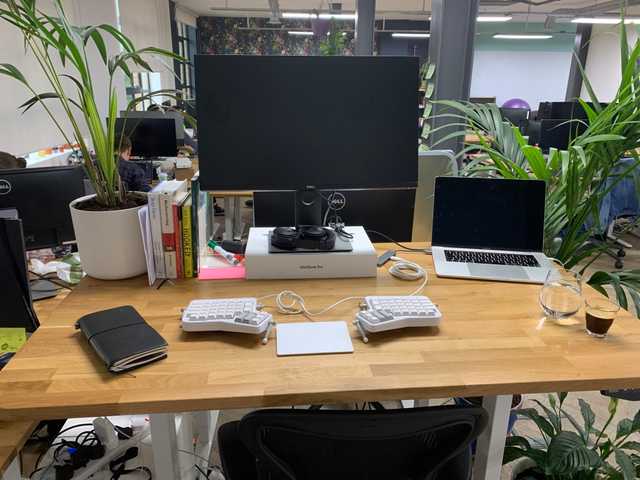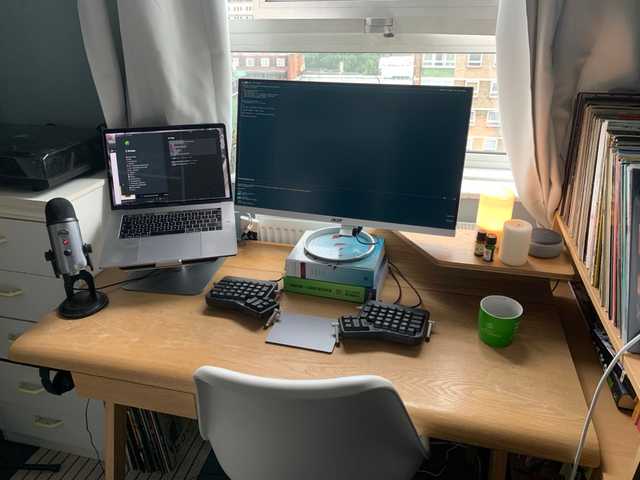RSI as a Developer
2019-08-24 • 1074 wordsTowards the end of last year, I decided to implement an improved linting setup on a large codebase. Although our code quality is now much improved, my wrists had to suffer through manually fixing ~3000 errors. For weeks, my productivity was slashed as I got dangerously close to having to stop coding completely because of the pain.
Fortunately, through a lot of experimentation, I’ve almost completely fixed my wrist issues. I wanted to summarise what did and didn’t work and share some tips with other developers to save them having to go through the same thing.
Successful Strategies for Reducing Wrist Pain
Buying a New Keyboard (and Free Alternatives)
The biggest thing I could recommend is getting a new, ergonomic keyboard. It turns out the term ‘ergonomic’, much like ‘organic’, doesn’t really mean anything, so you might have to do some experimentation to find something that fits your body well. For me, that meant switching to the ErgoDox (EZ). People also seem to like Microsoft and Kinesis’s alternatives.
Although the way it fits my hands is a vast improvement over a laptop keyboard, the real advantage of the ErgoDox is being able to completely reorganise your keys. Because the layout is so weird and there are so many modifiers and layers available, you can fully design an ergonomics-first layout. The things that helped me most were moving my most used keys onto the home row and away from problematic little fingers that were previously having to strain (I love JavaScript’s use of back-ticks, but hate their standard positioning on the keyboard), creating a symbol layer that reduced the the usage of the Shift key and moving Shift and Control directly under my fingers, rather than out to the side. You can check out my layout here.
If you can’t afford to buy a keyboard for yourself (or if you can!), ask your employer if they can help you out. I was surprised when I spoke to other developers and they were ashamed to ask for something which cost less than 1% of their salary yet could dramatically increase their productivity. When you factor in that a new keyboard will probably also help you type a great deal faster, its a no-brainer for your employer to cover the expense.
If you have an irrational employer, are self-employed, or are otherwise unable to afford a keyboard, you can still hack together a new ergonomic layout. Mapping my ErgoDox made me wonder what other improvements could be made to my standard laptop keyboard for when I was travelling or working from coffeeshops.
One common trick I see is to remap the Caps Locks key to Control so that you don’t have to strain to the bottom left. You can do this via Settings > Keyboard > Modifier keys on a Mac.
If you want to do a more complete remapping like me, I also found a great, free bit of software called Karabiner Elements. This app has allowed me to add a second Control on the right of my keyboard, move my shift keys to a more comfortable position, and convert that weird ‘§‘ symbol to a vim-friendly, mechanical Escape key on my Touch Bar Mac.
Desk & Keyboard Positioning
Your desk is almost certainly too high. I’m 6’4” and 80% of desks I use are too high for me. If you hold your elbows at a right-angle, your keyboard needs to be just below your hands in order to keep your wrists straight. You want to aim to hover, not rest at an awkward, upwards angle.
The second thing you want to watch out for in typing position is a wrist-breaking upwards slope. I don’t know why exactly this is (perhaps it’s inherited from mechanical typewriters needing their keys in the correct place), but most keyboards slope upwards, causing your wrists to bend as you type. I found it far more comfortable to tilt my keyboard downwards and outwards slightly so that the two halves now somewhat resemble the outside of a large sphere that I can rest my hands upon comfortably.
Typing Properly
Finally, you need to learn to type properly. Even though I could touch-type proficiently before I got RSI, I was still making a couple of painful mistakes.
The main mistake was chording. Chording is where you use one hand to type two distant keys. Press Shift-T on your keyboard with only your left hand and you’ll see what I’m talking about.
The solution to this is using opposing hands properly. When you press a letter with one hand, make sure you use the other hand to press the shift key. This gets rid of painful stretching (and should speed up your typing as an added bonus).
There are other minor bad typing habits that I picked up which I solved in an effort to lessen RSI. Using the wrong fingers on X, C, and B, only typing with one or two fingers on each hand and typing harder than I needed all caused me unnecessary discomfort. Honestly, the orthogonal layout of the ErgoDox was the best way to correct these behaviours, but you could also film yourself typing or go carefully through an online touch typing tool to make sure you’re using the correct keys at all times.
Failed Attempts
Throughout my experimentation, I tried several other strategies that seemed to be ubiquitously recommended across the internet yet were useless pieces advice for me personally.
Obviously, take a break where possible. However, your job most likely involves a lot of typing and being told to stop typing might seem analogous to being told to stop eating. So while I did try to type a little less, this advice was more irritating than it was useful.
I also read a lot of advice that told me to stop using my mouse. This didn’t really make much sense to me as I could clearly feel my wrists hurting more when typing than when using my mouse.
Above all, you should know that this is a solvable issue and not something to fret about. Take it easy for a week or two, try out some of the solutions in this article, and you’ll be seeing improvements in no-time.
Are you a developer looking to improve your typing? You might want to check out my touch typing tool, TypePerf.
Go any other tips? Tweet me, email me me and or join the discussion on Hacker News.

